One of the best ways to experience the culture of any country is through its music. Local clubs and clubs are informal venues perfect for exploring current and popular sounds. For a more formal introduction to classical genres, churches, major concerts, and music festivals are an excellent place to start.
Dance and music go hand in hand, especially in Latin countries. Salsa, samba, merengue, and cumbia are popular styles of dance music among older generations. Mexican music is also popular in Costa Rica, due to Costa Rica’s great exposure to Mexican culture many years ago. Local nightclubs and access points in San José and other metropolitan areas are probably the best way to enjoy music and participate in dancing.
The place to explore Costa Rican folk music is in the province of Guanacaste. The pre-Columbian style of music can be heard through ocarinas and ‘quijongos’, but many modern instruments can also be used to explore ceremonial songs and the heritage of the past. Today’s most popular music in Costa Rica combines rock, Latin sounds, jazz, and traditional folk music.
4 well-marked regions can be identified as a source of national folk and folk music: Guanacaste (Guanacasteca), the Central Valleys (Vallense), Limón (Limonense), and San Isidro de El General (Generaleña).
Description of some of the rhythms of typical and folk music
As an initial clarification, it should be noted that not necessarily a composition belongs exclusively to a particular genre. The same piece of music can be adapted to perform in different rhythms.
This is the case, for example, of the song “De la Caña, el Guaro” which has had many rhythmic versions: it has been recorded in the rhythm of Mexican corrido (Kike de Heredia), northern Mexican (Maribel Guardia), cueca Chilean (Los de Ramón), and even in rock (José Capmani). So it is not strange to find the same song, which is performed in different rhythms
Costa Rican Waltz
It arrived in the country between the 17th y 19th centuries and prevailed as the representative of the aristocratic classes of Carthage and San José. Subsequently, with some compositions of the 20th century, it acquired its nuances in songs such as ‘La caña está hecha de la caña’: anonymous (slow waltz)
Some Costa Rican waltzes
‘Baldazo’ – Luis Castillo C.
‘Coyotillo’ – (anonymous)
‘El amigo’ – Manuel María Gutiérrez
National Bolero
Like the ballad, the bolero is originally from Europe. It arrived in America, brought by the Spaniards, first to Cuba, in the 19th century, where he had a wide diffusion. There, it was mixed with African rhythms and maracas were added to its interpretation. This resulted in the cadentious song we know today.

It arrived in Costa Rica at the beginning of the 20th century, brought by some singers traveling through Central America, around the 1920s. Perhaps the most prolific national bolero composers, whose songs have crossed borders and have been recorded by famous singers, are Ricardo Mora, Orlando Zeledón, and Ray Tico.
About our main boleristas, they stand out among many other interpreters: Jorge Duarte, Gilberto Hernández, and Rafa Pérez. National composers have been prolific in this genre. As an example, within the best known Costa Rican boleros, it is worth mentioning:
Some of the best known Costa Rican boleros
‘Cartaginense’ – Carlos M. Hidalgo
‘Eso es imposible’ – Ray Tico (José Jacinto Herrera Córdoba)
‘Luna de Liberia’ – Jesús Bonilla Ch.
Mazurca and Polka
Rhythms originally from Poland, defined as cult music for high society. Both genres spread throughout Europe in the mid-18th century and arrived in Costa Rica with Catalan immigrants in the late 1840s. It quickly became popular as ballroom dancing for elegant parties.
Among the most prominent composers who exploited this musical genre is Manuel María Gutiérrez (author of the National Anthem), with mazurcas like ‘Chepita’, ‘Ester’, ‘Los Guerreros’, ‘La Viviana; and polkas such as ‘La Nueva Era’, ‘Las Josefinas’, ‘Ana Benita’, and La Isabel. Within modern groups, ‘Malpaís’ has a composition called ‘Mazurka de Dámaso’. Miguel Salguero, on anonymous music, composed the Mazurka ‘La Pava Negra’.
Tambito
The rhythm of folk music, of unknown origin, although it could be derived from Spanish dance. Some consider this the national rhythm. The name ‘tambito’ was coined by José Ramírez Saizar, about to the ‘tambo’, a type of ranch that was built on cattle farms for the laborers to sleep.
The tambo seems to be an Inca term; they used their famous drums as resting places on the Inca route. Among the songs that belong to this rhythm are:
Some of the best- known tambitos
‘A mi bandera’: Mario Chacón
‘Ésta es mi tierra’: Mario Chacón
‘Caballo Nicoyano’: Mario Chacón
Limonense calypso
It is a cadentious Afro-Caribbean rhythm, whose origin is attributed to the islands of Trinidad and Tobago. The route it followed to get to Costa Rica is not well known, although it is presumed that it first arrived in Jamaica and, from there, blacks brought it to the province of Limón where, because of its contagious pace and cadence, it quickly went adopted by the population.

Since its arrival with Jamaicans and the other Caribbeans in the penultimate decade of the 19th century, the rhythm began to acquire its nationality. In the first half of the 20th century, it had a great development as a spontaneous cultural manifestation Limón began to mix with the influence of many other local rhythms such as waltz, ‘parrandera’ or ‘tambito’, and imported such as Cuban, Colombian, and Mexican cumbia, as well as reggae and salsa. This has produced a calypso with a native flavor
Over the years, various instruments have been incorporated. It started with drums, maracas, and drums, but progressively the bongoe, ukulele, the Colombian bagpipe, the ‘shekele’ (shaker), the drawer, guitar, clarinet, harmonica, and others were incorporated.
Some of the best known Limonense calypso
‘Cabin in the Wata’, ‘One pant man’, ‘Black man’s food’, ‘Tacuma’ and ‘Anancy’, ‘Carolyne’ – Walter Ferguson
‘Mirror’ – Manuel Monestel‘Hellen’ – traditional Limonense folklore
